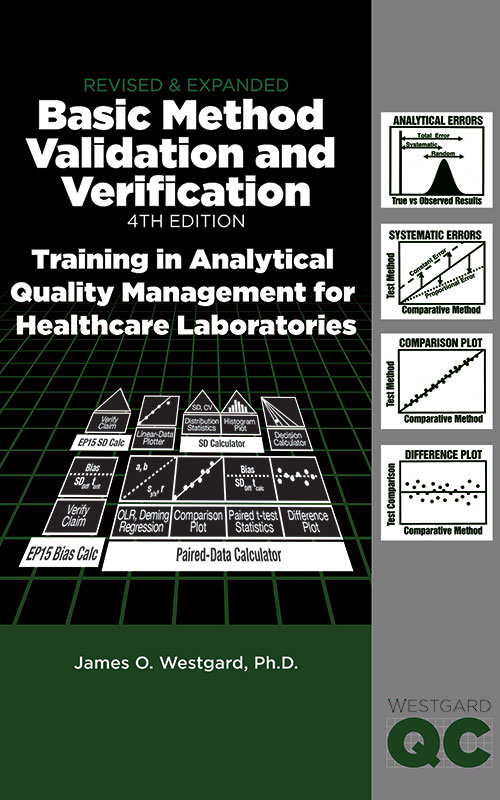Basic Method Validation
Reference Interval Transference
It's not some new age religion, it's yet another confusing aspect of method validation. This time Dr. Westgard teams up with Trish Barry to explain the ins and outs. (Preview)
| Note: This lesson is drawn from the first edition of the Basic Method Validation book. This reference manual is now in its fourth edition. The updated version of this material is also available in an online training program |
MV - The Transference of Reference Intervals
Purpose
The reference interval is the last characteristic to be studied in the method validation process. It is generally studied last because the reference interval itself doesn't enter into the decision on method acceptability and the study isn't needed when method performance is unacceptable. If method performance is acceptable, then it is important to assess the reference interval(s) to support the interpretation of patient test results.
Background
A reference interval is typically established by assaying specimens that are obtained from individuals that meet carefully defined criteria (reference sample group). Protocols such as those of the International Federation of Clinical Chemistry Expert Panel on Theory of Reference Values [1-6] and the National Committee for Clinical Laboratory Standards [7] delineate comprehensive, systematic processes that use carefully selected reference sample groups to establish reference intervals. These protocols typically need a minimum of 120 reference individuals for each group (or subgroup) that needs to be characterized.
For example, to establish a reference interval for hemoglobin - a test that is gender dependent - the laboratory would need to obtain hemoglobin results on 240 reference individuals (120 men and 120 women). These individuals are typically recruited from the general regional population (essentially the facilities' market-base) and then selected for inclusion in the study using carefully defined criteria. The selection is often accomplished by administering a health questionnaire. Sometimes a physical examination is also required as a way to determine acceptability for inclusion.
The establishment of reference intervals requires careful planning, control, and documentation of each aspect of the study. Thus, the resulting reference intervals are well-characterized in terms of the variation attributable to pre-analytical and analytical factors. These formal protocols are particularly helpful when a laboratory needs to establish its own reference interval for a particular test. This situation may occur if a laboratory has modified a previously FDA-approved method or developed an in-house test. Unfortunately, these protocols are resource-intensive and can be prohibitive for smaller facilities in light of current cost directives. Even large laboratories are finding it increasingly difficult to conduct these comprehensive studies cost-effectively. Therefore, laboratories are becoming more reliant on manufacturers to establish scientifically sound reference intervals that can be verified using simpler, less labor-intensive, and lower cost approaches.
In this lesson, the focus is on the "transference" of reference intervals, which requires considerably less effort and less data than necessary for the establishment of reference intervals. The reference interval that is of most interest during the method validation process is one that describes the test values typically observed in a "healthy" population. This interval has historically been referred to as the "normal range" and is derived by assaying specimens from individuals who meet criteria for "good" health (e.g., "have no known health problems, are ambulatory, not on any regular medication regimen, have a weight within the recommended norms, etc."). The test results (reference values) from this sample group are analyzed statistically to determine an interval of values that includes a specified percentage of all the values (reference interval) from the sample group. By tradition, this interval includes 95% of the values (usually the central 95%). A pair of test values (called the lower and upper reference limits) represents the boundaries of the interval. Patient results falling outside the reference limits are typically flagged in some way as "abnormal" results.
Transference approaches to consider
The NCCLS Approved Guideline C28-A [7] describes different ways for a laboratory to validate the "transference" of established reference intervals to the individual laboratory:
1. Divine judgment. The acceptability of the transfer may be subjectively assessed on the basis of consistency between the "demographics and geographics" of the study population(s) and the demographics of the laboratory's test population(s). The laboratory simply reviews the information submitted and subjectively verifies that the reference intervals are applicable to the adopting laboratory's patient population and test methods. To do this, all the information about the original study should be requested and made available to the adopting laboratory. This includes the demographics of the reference sample group, the selection process, pre-analytical conditions of the study such as subject preparation and specimen collection and handling techniques, the analytical system used, and the statistical method used to establish the intervals. Sometimes it is useful to request the original reference values and to re-analyze them to verify the original statistical analysis. Most cases for transference involve adoption of intervals from another laboratory using the same analytical system or intervals established by the method manufacturer.
- US CLIA regulations permit the Medical Director of a laboratory to make this assessment and judgment.
- While transference requires only the appropriate signature, the approach depends on a careful investigation of published recommendations, access to appropriate information, and significance laboratory and medical experience to assure the comparability of conditions.
- Provision of reference intervals for sub-populations, particularly the pediatrics year-by-year intervals, often requires this approach because of the difficulty in obtaining sufficient specimens to experimentally establish or verify reference intervals.
We invite you to read the rest of this article.
This article, plus many more important, updated, and expanded chapters are available in the Basic Method Validation manual, 4th Edition

